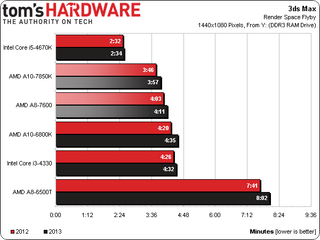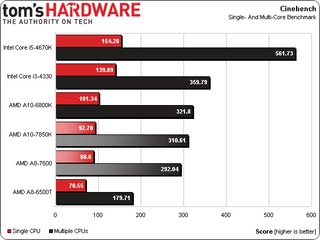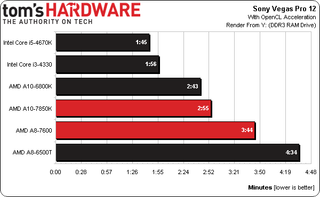AMD A10-7850K And A8-7600: Kaveri Gives Us A Taste Of HSA
We've spent the days following CES benchmarking two of AMD's new Kaveri-based APUs. Do the Steamroller x86 architecture, GCN graphics design, and HSA-oriented features impress, or do they come up short against Intel's value-oriented Haswell-based parts?
Results: Content Creation

Based on our earlier exploration of per-cycle performance, we know that AMD’s Steamroller architecture yields a nice speed-up in 3ds Max. And even though A10-6800K enjoys higher frequencies, the A10-7850K and A8-7600 (65 W) still turn in slightly better results.
The top Richland-based APU trades blows with Intel’s Core i3-4330, incidentally at the same price. AMD’s A8-7600 isn’t available yet, but once it is, we expect it’ll impress at around $120. We’d have a much harder time arguing in favor of the A10-7850K for $50 more when it’s only marginally faster.

Both 3ds Max and Blender might be considered heavy lifting for low-cost PCs. But that doesn’t stop Intel’s dual-core Core i3 from performing surprisingly well in our render project, besting AMD’s dual-module Kaveri APUs. The A10-7850K narrowly beats AMD’s A10-6800K, while the A8-7600 lands just behind Richland’s quickest incarnation.
Benchmarks make it pretty clear that it’s worth stepping up to Core i5 (or better) if you’re into more demanding content creation apps…at least for now. After all, this would seem to be the type of workload AMD is talking about when it extols the virtues of HSA.

A pure CPU test, Maxon’s Cinebench strictly gives us the difference between host processing performance. Steamroller, operating at its manufacturing process-limited peak and base clock rates, turns out to be slower than A10-6800K.
No surprise—the Haswell-based chips are faster than Piledriver and Steamroller in a single-threaded benchmark. It’s less expected to see Core i3 in front of the APUs, though.

The same thing happens in Sony’s Vegas Pro 12 as Intel’s CPUs take first and second place, while A10-6800K slides past the Kaveri-based APUs. This is an OpenCL-accelerated workload, so it’s strange that AMD’s latest doesn’t turn in stronger numbers. But when we turn off OpenCL and run the same benchmark, completion time nearly doubles. So hardware acceleration is definitely helping, just not as much as we would have thought given AMD's more modern graphics architecture.
Stay on the Cutting Edge
Join the experts who read Tom's Hardware for the inside track on enthusiast PC tech news — and have for over 25 years. We'll send breaking news and in-depth reviews of CPUs, GPUs, AI, maker hardware and more straight to your inbox.
-
Someone Somewhere Yeah, almost all the diagrams refer to the 4760K.Reply
Given that AM3+ looks like it's done, it would have been nice to see a 6-core chip. Still, one of these may end up in my next laptop. -
spp85 A10-7850k is slower than A10-6800K ?? WTF. Its all hype than actual performance to the table. Even on OpenCL GPU accelerated apps doesn't have any advantage with A10-7850k over i5 or sometimes i3 CPUs. Hopeless is what I feel about AMD CPUs.Reply -
Someone Somewhere Reply12454254 said:A10-7850k is slower than A10-6800K ?? WTF.
I got the opposite impression. Which graph are you looking at? -
Jaroslav Jandek Thank you for the article (especially the power consumption measurements), Chris. It is definitely an improvement over Richland but kind of boring (disappointingly expectable).Reply
I really like where AMD is going (HSA, GCN and TrueAudio).Too bad the manufacturing process of GlobalFoundries just can't match Intel's.
Also, it would be interesting to see the new Bay Trail Pentium or Celeron CPUs (whichever is closer in performance) in the Efficiency graphs. -
Someone Somewhere I'm fairly sure that this is on TSMC's 28nm node. GlobalFoundries can't do that yet; this is on the same process used for AMD GPUs currently.Reply -
Jaroslav Jandek Reply
28nm SHP from GlobalFoundries. AMD bought over $1 billion worth of wafers from them in december...12454280 said:I'm fairly sure that this is on TSMC's 28nm node. GlobalFoundries can't do that yet; this is on the same process used for AMD GPUs currently.
I guess you have been reading the articles from a year ago about AMD still using TSMC despite promises of GlobalFoundries' new 28nm SHP process. -
jacobian I don't really believe into the whole HSA smoke-screen. By the time HSA-enabled apps take off, you will be ready to upgrade from your CPU again. The one terrible truth that stands out right now is that at current prices, the flagship Kaveri A10 doesn't make any sense whatsoever. Kaveri A8? Maybe. Richland A10-6790K? Perhaps. But the Kaveri A10 at $180 is a just a joke, specially after all that hype.Reply -
Someone Somewhere CPUs are usually released at ridiculous prices, and come down over a month or two.Reply
Most Popular


